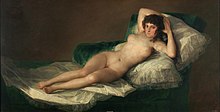| |||
|---|---|---|---|
| +... |
The year 1800 in art is often estimated to be the beginning of the change from the Neoclassicism movement, that was based on Roman art, to the Romantic movement, which encouraged emotional art and ended around 1850 and brought forth a new era of artistic exploration. Artists of that time departed from traditional norms, embracing fresh ideas and diverse subjects. This era blended classical principles with innovative concepts, capturing both contemporary life and historical stories. The art in 1800 set the foundation for later 19th-century movements, inspiring a new era of artistic creativity that continued to shape the course of artistic development for years to follow. [1]
Neoclassicism and Romanticism

The Neoclassicism [2] movement established the principles of classical antiquity and experienced high popularity in the late 18th and early 19th centuries. Artists embraced the ideals of ancient Greece and Rome, seeking to inspire their works with harmony, rationality, and order. The movement's emphasis on mythological and historical themes pursue to uplift intellectual and moral virtues.
One of the leading proponents of Neoclassicism was Jacques-Louis David, a distinguished French painter. His masterpiece, Portrait of Madame Recamier, represents the Neoclassical style with its balanced composition and refined lines. [3]

In contrast to Neoclassicism's emphasis on reason and restraint, Romanticism [4] celebrated emotion, individualism, and the sublime. Romantic artists pursued to induce powerful feelings and explored the complexities of the human psyche. They found inspiration in nature, folklore, and the supernatural.
A renowned Romantic artist was Francisco Goya, whose provocative and emotionally charged works challenged amusing norms. One of his notable pieces, La maja desnuda, represented the spirit of Romanticism and is considered a significant departure from Neoclassical conventions due to its sensual and emotive portrayal.
Legacy
Neoclassicism [5] and Romanticism [6] were influential movements that settle the foundation for further developments in the art world. While Neoclassicism emphasized idealism and classical values, Romanticism celebrated the individual expression and the raw emotions of humanity.
The interaction between these contrasting movements reflected the complexities of the 19th century, a time of revolution, industrialization, and societal change. The legacies of Neoclassicism and Romanticism continue to resonate in modern art, with artists drawing inspiration from both the rationality of the past and the emotional depths of human experience.
The 1800s in Art witnessed the rise of various other movements, each contributing to the diversity and richness of artistic expression during this transformative century. From the realism movement's depiction of reality to the innovative techniques of impressionism and the daring explorations of Post-Impressionism, the art world of the 19th century remains a captivating era of creativity and evolution.
Events
- May 31 – The National Art Gallery (Nationale Kunst-Galerij), precursor of the Rijksmuseum, opens in Huis ten Bosch in The Hague, Batavian Republic.
- François-André Vincent marries fellow-painter Adélaïde Labille-Guiard.
Works
- Jacques-Louis David – Portrait of Madame Récamier
- Heinrich Füger – portraits of Lord Nelson
- Francisco Goya – La Maja desnuda (approximate completion date)
- Henry Raeburn – The MacDonald Children (approximate date)
- George Stubbs – Hambletonian Rubbing Down
- Benjamin West – Joshua Passing the River Jordan with the Ark of the Covenant
Births
- January 12 – Eugène Lami, French painter and lithographer (died 1890)
- February 1 – Thomas Cole, English-born American landscape painter (died 1848)
- February 6 – Achille Devéria, French painter and lithographer (died 1857)
- February 9 – Joseph von Führich, Austrian painter (died 1876)
- February 22 – Richard Seymour-Conway, 4th Marquess of Hertford, English francophile art collector (died 1870)
- March 10 – Thomas Webster, English genre painter (died 1886)
- May 26 – Charles-Philogène Tschaggeny
- June 9 – James Wilson Carmichael, English marine painter (died 1868)
- July 2 – Piotr Michałowski, Polish portrait painter (died 1855)
- July 11 – Charles Lees, Scottish portrait painter (died 1880)
- August 10 – George Cattermole, English illustrator and watercolourist (died 1868)
- October 14 – John Hogan, Irish sculptor (died 1858)
- November 20 – Richard Rothwell, Irish portrait and genre painter (died 1868)
- date unknown
- Auguste-Joseph Carrier, French miniature painter (died 1875)
- Frederick Yeates Hurlstone, English painter (died 1869)
- probable
- Charles Codman, landscape painter of Portland, Maine (died 1842)
- Achille Leonardi, Italian artist (died 1870)
Deaths
- May 21 – Carl August Ehrensvärd, Swedish naval officer, painter, author, and neo-classical architect (born 1745)
- October 25 – Thomas Macklin, art dealer (born c.1753) [7]
- December – Jean-Baptiste Audebert, naturalist and artist (born 1759)
- December 5 – Carlo Frigerio, painter (born 1763)
- date unknown
- Manuel Acevedo, Spanish painter (born 1744)
- John Clayton, painter (born 1728)
- Francisco Agustín y Grande, Spanish painter of the Neoclassic style (born 1753)
- François-Nicolas Martinet, engraver and naturalist (born c.1760)
- Louis Rolland Trinquesse, painter (born c.1746)
- Henry Wigstead, painter and caricaturist
- probable – Nicolas Benjamin Delapierre, French artist (born 1739)
References
- ^ Aimee Marcereau DeGalan, ed. (2021). Neoclassicism and Romanticism, 1790–1860. The Nelson-Atkins Museum of Art, Kansas City.
- ^ Grafton, Anthony (2010). ""Neoclassicism." The Classical Tradition".
- ^ Palmer, Allison Lee (2011). Historical Dictionary of Neoclassical Art and Architecture. Scarecrow Press. ISBN 978-0-8108-7474-9.[ page needed]
- ^ Barker, Emma (2013). "Part 2, New worlds of art 1760-1850". Art & Visual Culture 1600-1850: Academy to Avant-Garde. Tate Enterprises. ISBN 978-1-84976-109-3.
- ^ Palmer, Allison Lee (2011). Historical Dictionary of Neoclassical Art and Architecture. Scarecrow Press. ISBN 978-0-8108-7474-9.[ page needed]
- ^ Rosenthal, Léon (2008). Romanticism. Parkstone International. ISBN 978-1-84484-458-6.[ page needed]
- ^ Charles Henry Timperley (1839). A Dictionary of Printers and Printing. H. Johnson. p. 804.